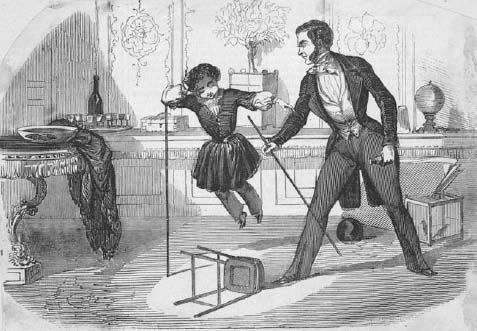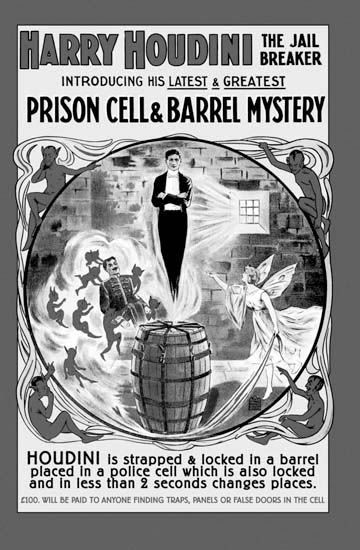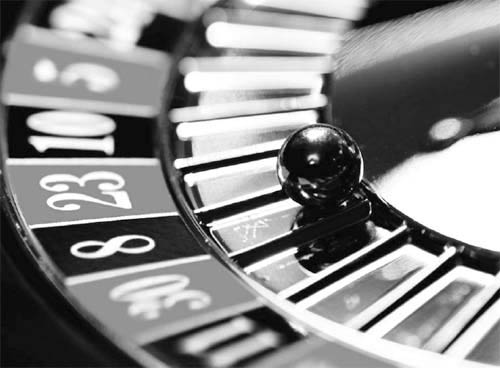Nothing Is Impossible: The Real-Life Adventures of a Street Magician (9 page)
Read Nothing Is Impossible: The Real-Life Adventures of a Street Magician Online
Authors: Dynamo
Tags: #Biography & Autobiography, #Entertainment & Performing Arts, #Games, #Magic

OVER TIME, I
realised the importance of knowing what your peers are doing. You can’t live in a world where only you and your magic exist; how can you learn and grow from that?
But while I may study other people’s concepts, I’ll always change them and make them my own. I’ll look at what someone’s done and take it to the next level: magicians may have walked on water before, but never on a body of water as dangerous as the Thames. I’ve admired and learnt from magicians including Houdini and David Blaine, and there are many magicians that I’ve been lucky enough to meet along the way who have added to my experiences, ideas and style.
Many people think magic started with Houdini, the infamous escapologist. Yet you can trace magic back to the dawn of time; it was probably called something else in those days. If you look at the drawings that cavemen used to do, there was certainly an element of mysticism in those paintings. Having a sense of wonderment, and questioning what is and isn’t possible, is, I think, an inherent part of human nature.
Recorded magic is as old as history itself. Around 5,000 years ago, a common man called Dedi was summoned to the palace of an Egyptian pharaoh called Cheops. Dedi was thought to be 110 years old and survived on 100 jars of beer, a shoulder of beef and 500 loaves of bread a day. After arriving at the palace, he
was asked to perform the magic he was famous for – decapitation. He grabbed a goose, a pelican and an ox, and, in turn, pulled off each of their heads with his bare hands. Once the stunned crowd had ascertained each animal was dead, Dedi picked up the head, took it back to the now-lifeless body and stuck it back on. Each animal immediately squawked back to life, running around the palace, much to the delight of the pharaoh and his subjects.
You can imagine his thoughts when the king asked him to perform the magic again on a prisoner. I’m not sure how he wangled himself out of that one…!
Throughout time and through many civilisations, from ancient Greece and Rome to medieval England, magicians have been a crucial part of society. Back then when there was no television, cinema, computer games, Twitter or BlackBerry, people had to make their own entertainment. Whether that was William Shakespeare entertaining the masses at the Globe, or the likes of the court jester amusing the Queen and her subjects, people have always wanted to be amazed and entertained.
It was around the nineteenth century that magic really changed. Before then, it had been the domain of the very poor or the very rich, taking place either in palaces or sewage-filled market squares. The middle classes sneered at magic, believing it to be for the simple and poor or the rich and bored. But then a Frenchman called Jean Eugène Robert-Houdin swapped the wizard cloaks for a top hat and tails. Robert-Houdin took magic to the theatre, giving it a physical home and a broader audience. Robert-Houdin was known for some incredible magic – most famously catching a bullet between his teeth. Magic had earned a newfound respect, finally beginning to shake off the stereotypes of ‘witchcraft and wizardry’.

After Robert-Houdin came the almighty Harry Houdini, who would go on to become one of magic’s most famous practitioners. Still widely regarded as the greatest ever escapologist, stunt artist, showman and magician of all time, Houdini awed millions of people all over the world during the late 1800s and early 1900s. He escaped from a straitjacket while being dangled upside-down from a crane one hundred feet in the air. He freed himself from an airtight case at the bottom of a swimming pool. Manacled in a lead-encased crate, he was lowered into New York’s East River and escaped in just fifty-seven seconds. There was always a new challenge that Houdini was willing to try.
Houdini eventually died in 1926 after receiving a series of blows to the abdomen by a university student named J. Gordon Whitehead. Whitehead had asked Houdini if it was true that he could take any amount of punches to the stomach, to which Houdini, lying down on a couch at the time, had replied yes. Houdini stood up, but before he had time to prepare himself properly, it is said that Whitehead unexpectedly hit him three times in the stomach. Already ill with a ruptured appendix, he continued to perform but died a couple of weeks later on 31 October of peritonitis. He was fifty-two years old.

Through Houdini, and others like Robert-Houdin, David Copperfield and Siegfried & Roy, magic became a legitimate art form, as revered by society as music, painting or sportsmanship. There’s a reason why David Copperfield is one of the top ten highest-paid celebrities worldwide. This guy stood in the centre of a ‘tornado of fire’. He escaped from Alcatraz. He made NASA angry when he made the moon vanish for four seconds. You don’t get to play to the amount of people that Copperfield has and make the money he has made by being ‘quite good’. And he is not the only master of his trade. Penn and Teller might have a very different style to Copperfield, or indeed to me, but they are without question the best magic duo out there. They are constantly reinventing what magic is and I respect them greatly for that.
The entire history of magic is really a whole other story, but I wanted to give a little insight into how it all happened because, as I always say, if you don’t know where you’ve been, how do you know where you’re going?
In those early years, I had a lot of lessons to learn, and it’s because of meeting people like Daryl the Magician that I was able to hone my magic and start to see success. As well as observing Gramps, I soaked up ideas from the street performers in New Orleans and other professionals like Lee Asher, Mac King and Wayne Dobson. They may not be household names, but within the world of magic, they’re respected by the best.
That’s what I learnt during my time in America that year. I went with the idea that magic would be a lifetime hobby; I left with the knowledge and the knowhow to turn it into a career. I guess I should be thankful to those Golden Retrievers!

CHAPTER 4
AVOIDING THE STRAIGHT LINES

WHILE I WAS
in Memphis, I made a decision. I was going to move to Las Vegas, the home of magic. I’d seen how the likes of Daryl the Magician had built their careers and I was inspired. I’d had such good feedback from doing the dog shows and the odd performance in Memphis that I felt confident I could make my name in Vegas. My vague, some might say insane, plan was that word of mouth would spread and my own television show would soon follow. Simple.
I returned home and formulated a plan. I would get myself a gaming licence so that I could work in Vegas when I turned twenty-one. I figured that I’d get a licence in Bradford, sort out a placement in Vegas and then pursue my career in magic, but have the licence to fall back on if anything went wrong.
I got myself a trainee position working as a croupier for Gala Bingo in Bradford. A croupier is someone who works in a casino on everything from the blackjack table to the roulette wheel. I would take people’s bets as well as working out what they’d won.
I’d always been pretty good at maths, which is essential in the job, and I spent a lot of time adding and multiplying at scarily fast rates. I didn’t realise it at the time, but thinking fast on my feet would bode well in later years; particularly when it came to doing predictions. Being able to work out the odds of something quickly is not a bad skill to have in my line of work.

This being Bradford, it wasn’t all glitz and glamour; there was no Sharon Stone lounging half-naked over the Texas Hold’em table and James Bond swilling his specially shaken Martini. It was working-class people standing on gaudy carpet with bright overhead lights, lots of late nights, and because it was before the smoking ban, the club would be full of clouds of B&H as punters puffed away over the tables. I’d leave in the early hours of the morning, physically and mentally exhausted, stinking of smoke, sweat and the spilt drinks of customers who’d gotten carried away with the booze.
Despite all that, I enjoyed the work. I was always busy and it was well paid and I had a goal in mind. I was working towards something and as I saw my savings slowly increase, it gave me even more impetus to work long, unsociable hours. My boys
may have been out partying, but I couldn’t let that be my life at that point; I needed to stay focused on my goals: a licence and Las Vegas.
I managed to save a couple of thousand pounds quite quickly and, a few months later, I had enough money to take a short holiday to the infamous Sin City. I landed at dusk, and because the airport is so close to the main strip I could see the sun setting over the ‘Eiffel Tower’, the ‘Pyramids’ and the ‘Statue of Liberty’. The lights of Vegas are so bright, you can see them from space. As I left the airport terminal to jump in a cab, the view of the city as it turned from dusk to evening was pretty magical.
It’s no surprise that magic does such big business in this city: it’s loud, brash and full of empty promises and broken dreams. When you’ve lost your life savings on the roulette wheel or the blackjack table, you’re going to want to see something that gives you hope. In some ways, Vegas is the home of magic. It’s where all the main players ‘retire’ to when they’re ready to do a few years of shows and make their millions on the constant stream of audiences that pour into the city each day.
